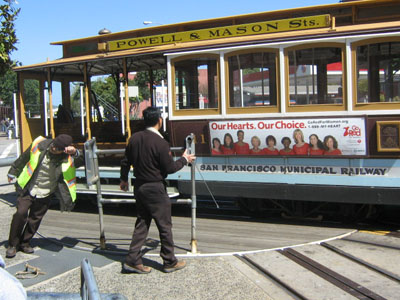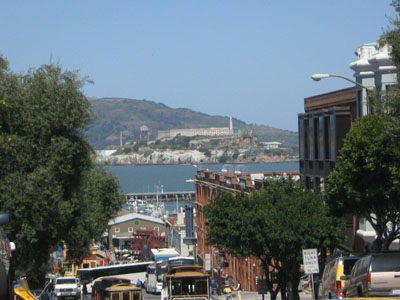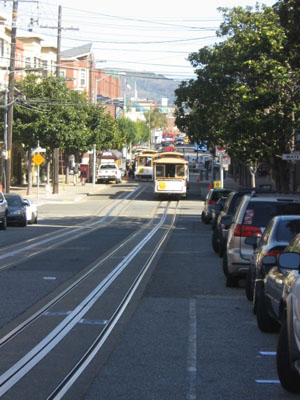
Cable cars are easy way to tour city
SAN FRANCISCO— It’s hard to walk through San Francisco without seeing them. They’re big, brightly colored, they have bells that their conductors regularly ring, and they have crowds of people hanging off the edge of them.
They are the last permanently operational manually operated cable car system in the world and they are a moving historical landmark.
So, when someone visits San Francisco, the cable cars are definitely something to ride. Not just because they are an integral part of San Francisco’s charm, but because they’re a great way to see the city.
|
When the car reaches the end of the line, a conductor and a gripman will help push the car around on a turntable. Since the cables don’t run in a loop, this is the only way to turn the car around. |
 |
Terry Carter, visiting with her daughter from Chicago, saved their ride on the cable car until the end of their trip.
“We needed to get this in,” said Carter. “And it’s actually a great thing we saved it for last, since we can see everything we may have missed.”
Indeed, with three lines servicing different parts of downtown San Francisco, several of the city’s landmarks are visible from the car, regardless of where your seat (or standing spot) happens to be. Fisherman’s Wharf, Union Square, Chinatown, and Ghirardelli Square are just some of the locales to see.
“It’s the one thing everyone wants to ride,” said Jimmy Cee, a conductor for eight years. “It is definitely a major tour attraction.”
And that attraction is enhanced by the knowledge that if you see a place you like, you can alert the driver, known as a gripman, and hop right off.
 |
One of the “best views” of the city from the cars—Alcatraz and Fisherman’s Wharf. |
One example is Lombard Street, viewable from the Powell-Hyde line. The car groans and the bell clangs as it pauses to let viewers snap a photo of the twisting zig-zag street below.
“Can you walk down it?” A passenger asked the gripman.
“Yeah, and you can roll down it, too,” was the reply.
That came from Byron Bailey, a 20-year veteran of cable car conducting.
“If you come to San Francisco, this and the Golden Gate Bridge are the main attractions,” Bailey said. “My personal favorite view is looking down Hyde Street. You can see the Golden Gate Bridge, Alcatraz and East Bay for about four miles. It’s the perfect view.”
Traveling at a maximum of 9.5 miles per hour, the cars are all connected to the Cable Car Museum, located on Nob Hill. Conveniently, all three lines stop at Nob Hill for easy access to the museum. The cables underground constantly move, similar to the way a ski lift operates.
Bailey is one of many gripmen that control the cars. And, just as the cars are ways to see the diversity of the city, so too are the gripmen a good way to see the diversity of the people.
Each car is a unique ride and the gripman plays a big part in that. You may see long beards, pierced ears and talkative gripmen. Others stop and holler at locals on the street. Some are quiet and just get you from station to station. It’s a tossup of who you may end up with, but they’re all generally pleasant, and a good way to see just how distinct the city’s inhabitants are.
|
A car on the Powell-Mason line moves down the road. |
 |
Bailey rang the bells in rhythm as he controlled the vehicle down the path, creating a nice little jingle to go along with the movement of the car. He also had humorous responses to actions and questions from passengers.
“Don’t lean off the side,” he said to a teenage rider who was being a bit too adventurous. “Well, actually you can, if you want a facelift.”
Not everyone is that daring, though.
“I like keeping all of my body parts intact,” said Kelsey Nomant, a first-time rider who remained seated for the duration of her ride. “I never know when I’ll need them.”
Others think standing and hanging off of the edge is a plus. It’s certainly a unique experience, feeling the wind whipping past your face as you glide down a hill. And when you pass by other cars, you may get to view a bell-ringing battle between gripmen, and your fellow riders are so close you can high-five them, or even hop onto their car. While that is definitely not recommended, it is feasible.
The interaction with other cars as well as the thrill of being partially off of the trolley make the cable cars seem like they would fit right in at an amusement park.
“This was my first time riding,” said James Kowan of Los Angeles. “And you have to be standing up to really experience it.”
“The best spot is right at the front,” said Bailey. “Either the left or right side. You get the view of a fly on the windshield.”
And that view is a fantastic one. No people in the way to block any of the beautiful sights and to feel the wind going through your hair as you look out over San Francisco is as exhilarating as riding a roller coaster.
Although many locals tend to avoid the cable cars and prefer the more conventional means of transportation, visitors should step right up. And don’t be shy.
“A lot of the drivers will usually just wave at a spot if they see you and let you hop on,” said Dawn Haskins, who works at the Cable Car Museum as a salesperson. “It’s a tradition, a moving landmark. Plus the buses tend to make me sick, so I’d much prefer a trolley or streetcar.”
“They are a part of the feel of the whole city,” added Monica Youssef, a San Francisco native. “When you’re on a cable car going down one of the steep hills, overlooking the bay and Alcatraz, you know you’re in San Francisco!”
There are plenty of things to do if you invest some time in the cable cars. You can see all sorts of sights of the city. You can meet new people—after all, when you’re standing on the side of the cars there’s not much to do except stare at the people seated right in front of you. And you can get the thrill of an amusement park ride without the long lines or steep costs.
“Sure, it’s all touristy,” Cee said. “But it’s a fun ride, so why not?”
“It doesn’t go too fast,” said Stephanie Bond, who was visiting from New York. “And it makes lots of stops, so you have plenty of time to take pictures and see all the surroundings.”
And with so many surroundings to see, you might as well get your ticket and hop on. The cars will be waiting.
If You Ride
- Cost: $5 for a one-way ride, seniors (65 and over) may ride for $1 before 7 a.m. and after 9 p.m.
- Muni Passports are accepted on all Muni vehicles—cable cars, historic streetcars, and trolley buses. 1-day ($11), 3-day ($18), and 7-day ($24) are available.
- Monthly passes ($45 for adults, $10 for seniors 65 and over, children 17 and under, and disabled) and Weekly passes ($15 + a cable car surcharge of $1 per trip can also be purchased.
- There are three lines: the Powell-Mason (Line 59), the Powell-Hyde (Line 60), and California Street (Line 61).
- For more information on the lines and some other rider’s guides, check out the official San Francisco Cable Car website at http://www.sfcablecar.com/
- You can board on the start of each line, or anywhere you see a sign advertising one or more of the lines stopping at the intersection. It’s actually easier to board at one of the stops along the line, as there is less of a wait and you may be able to avoid paying, as well.

Comments are Closed